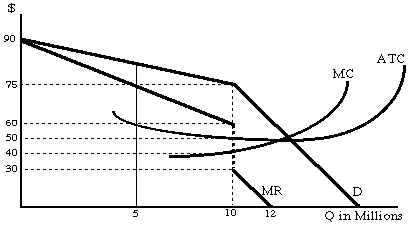
Figure 1
- $750 million.
- $250 million.
- $350 million.
- $600 million.
- $500 million.
- reduce output and increase price.
- increase his price but leave output the same.
- leave price the same but reduce output.
- operate at a loss.
- leave price and output levels unchanged.
- if it increases or lowers price, all other firms will follow.
- if it reduces price other firms will enter the industry, but if it increases price firms will exit.
- if it increases price other firms will enter the industry, but if it reduces price firms will exit.
- if it reduces price, all other firms will follow, but if it increases price no other firms will.
- if it reduces price, no other firms will follow, but if it increases
price all other firms will.
- more than 12 million.
- 10 million.
- 5 million.
- less than 5 million.
- between 5 and 10 million.
- it actually cost more to print journals for libraries than for individuals so the price difference reflects true cost differences.
- libraries have more inelastic demands for technical journals that individuals so the publishers are able to engage in price discrimination.
- libraries have more elastic demands for technical journals than individuals so the publishers are able to engage in price discrimination.
- individuals need the journals more so the publishers gives them a break.
- the publisher is charging a ''price per reader'' rather than a
price per journal.
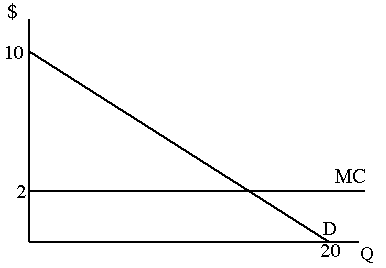
Figure 2
- .
- .
- .
- .
- .
- to produce 8 units and charge a price of $2.
- to produce 8 units and charge a price of $6.
- to produce 10 units and charge a price of $2.
- to produce 10 units and charge a price of $5.
- to produce 6 units and charge a price of $7.
- is $2,000 per year.
- is $3,000 per year.
- is $4,000 per year.
- is $8,000 per year.
- can not be computed with the given information.
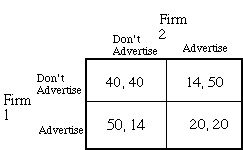
Figure 3
- both firms 1 and 2 will play their dominant strategies and earn profits of 40 each.
- both firms will flip a coin to decide what to do.
- both firms 1 and 2 will play their dominant strategies and earn profits of 20 each.
- our best prediction is that the outcome will be the Nash equilibirum where each earns profits of 40.
- the firms will collude and both agree to advertise.
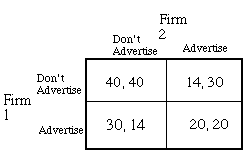
Figure 4
- both firms 1 and 2 will play their dominant strategies and earn profits of 40 each.
- both firms will flip a coin to decide what to do.
- both firms 1 and 2 will play their dominant strategies and earn profits of 20 each.
- our best prediction is that the outcome will be the Nash equilibirum where each earns profits of 40.
- the firms will collude and both agree to advertise.
- tacit collusion will be easier in the industry with the concentration ratio of .12 and thus we expect profits in that industry to be lower.
- tacit collusion will be easier in the industry with the concentration ratio of .95 and thus we expect profits in that industry to be higher.
- tacit collusion will be easier in the industry with the concentration ratio of .12 and thus we expect profits in that industry to be higher.
- explicit collusion will be easier in the industry with the concentration ratio of .12 and thus we expect profits in that industry to be higher.
- tacit collusion is unrelated to the four firm concentration ratio
and thus we can make no good prediction about profits in these
two industries.
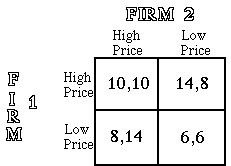
Figure 5
- both firms will play their dominant strategies and each will earn profits of 10.
- both firms will play their dominant strategies and each will earn profits of 6
- Firm 1 will charge a low price and Firm 2 will charge a high price.
- Since there is no dominant strategy we can't make a prediction.
- Firm 2 will charge a low price and Firm 1 will charge a high price.
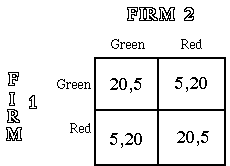
Figure 6
- firm 1 likes green and firm 2 likes red.
- neither firm cares about color, they just want to be different from each other.
- firm 1 likes red and firm 2 likes green.
- the firms don't care about color, but firm 1 wants to be different from firm 2 and firm 2 wants to be like firm 1.
- the firms don't care about color, but firm 1 wants to be like
firm 2 and firm 2 wants to be different from firm 1.
- each firm plays its dominant strategy and gets a payoff of 20.
- each firm chooses its pure strategy Nash equilibrium play.
- each firm pursues a mixed strategy.
- firm one always plays green and firm two always plays red.
- firm one always plays red and firm two always plays green.

Figure 7
- 8.
- 7.
- 5.
- 4.
- 3.
- 9.
- 8.
- 7.
- 5.
- 4.
- An increase in the average price of diamonds an increase in the quantity sold and an increase in profits.
- An increase in the average price of diamonds a decrease in the quantity sold and an increase in profits.
- No change in the average price of diamonds an increase in the quantity sold and an increase in profits.
- A decrease in the average price of diamonds a decrease in the quantity sold and an increase in profits.
- A decrease in the average price of diamonds an increase in the
quantity sold and an increase in profits.
| TABLE 1 | |
|---|---|
| Data For Firm A | |
| Price | Units Sold |
| 10 | 100 |
| 9.95 | 101 |
| 9.90 | 102 |
| 9.85 | 103 |
| 9.80 | 104 |
| 9.75 | 105 |
| 9.70 | 106 |
| 9.65 | 107 |
| 9.60 | 108 |
- Raise price by a lot. Since marginal cost is less than half the price, it will be profitable to increase prices by a great deal.
- Reduce price by almost $5.20 so that price will be close to marginal cost, which will maximize the monopoly profit.
- Reduce price to $9.95 because that is just barely lower than current and will split the marginal cost versus marginal benefit difference.
- Reduce price to $9.90 since that will set the added revenue just slightly above the additional costs of production.
- Reduce price to $9.60 since that will set the added revenue just slightly above the additional costs of production.
-
- You recommend that prices be increased more than before in the hopes of passing the costs of the retainer along to your customers.
- You recommend that prices be lowered more than before so the extra sales will make up for the extra costs.
- You recommend the same price you recommended before since this extra cost is not related to the number of units your firm produces.
- You recommend that the firm find a new demand curve so that prices and quantities can be recomputed.
- You recommend that price be the same but that output be doubled
in the hope of earning extra revenue.
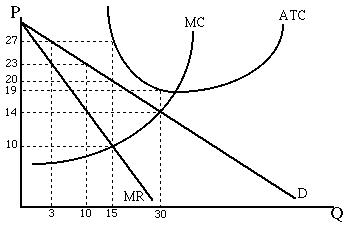
Figure 8
- Q=10, P = 23
- Q = 15, P = 27
- Q = 15, P = 20
- Q = 25, P = 15
- Q = 25, P = 18
- 105
- 75
- -105
- -255
- -75
- Charge a higher price and produce a larger quantity
- Charge a higher price and produce a smaller quantity
- Charge a lower price and produce a smaller quantity
- Charge a lower price and produce a larger quantity
- The long run result is the same as original result

Figure 9
- consumers will be willing to pay $6 for one more unit of the good while it would cost the firm $4.50 to product another unit.
- consumers will be willing to pay $5 for one more unit of the good while it would cost the firm $5.00 to product another unit.
- consumers will be willing to pay $5 for one more unit of the good while it would cost the firm $4.50 to product another unit.
- consumers will be willing to pay $10 for one more unit of the good while it would cost the firm $5.00 to product another unit.
- consumers will be willing to pay $10 for one more unit of the
good while it would cost the firm $3.00 to product another unit.
- incurring economic losses of $20.
- earning economic profits of $50.
- earning economic profits of $70.
- earning economic profits of $15.
- earning exactly 0 economic profit.
- It will charge a higher price and produce a larger output.
- It will charge a higher price and produce a smaller output.
- It will charge a lower price and produce a smaller output.
- It will charge a lower price and produce a larger output.
- The firm is in long run equilibrium.
- $10,000
- $500
- its value is infinite since it's good forever.
- $200,000
- $50,000
- the firm will not change its production behavior.
- the firm will lower its marginal and average costs to increase profits.
- the firm will advertise to increase demand thus restoring its profits.
- the firm reduce price and increase output.
- the firm increase price and reduce output.
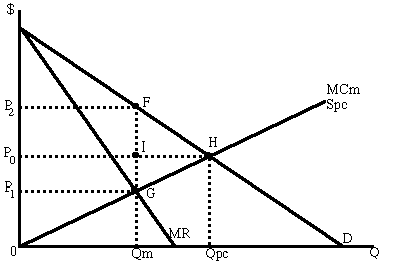
Figure 10
- 0 H PO
- P2 F H PO
- P1 G F P2
- P2 F G 0
- P1 G 0
- F H I
- G H F
- PO H G P1
- P2 F H P0$\
- I H G
- monopoly power.
- externalities.
- imperfect information.
- profits.
- collusion to reduce output.
- it is generally believe that monopolies produce higher quality products than would many small firms.
- consumers prefer not having to decide which firm is best.
- total costs of producing the same amount of output would be much higher if produced by many small firms.
- its easier to regulate one large firm than many small ones.
- collusion is easily prevented in monopoly.
- would be tacitly colluding.
- would be explicitly colluding.
- would be operating in the best interest of the consumer.
- would be effectively merged.
- would be practicing predatory pricing.
- It did not prevent anticompetitive or monopolizing mergers through stock or share purchases.
- It did not prevent anticompetitive price discrimination.
- It did not prevent anticompetitive tying contracts
- It did not prevent anticompetitive or monopolizing mergers through assets purchases.
- It did not prevent directors of one company from being directors
of another company in the same industry.
- $2,000 per year
- $3,000 per year
- $4,000 per year
- $8,000 per year
- cannot be computed with the given information.
- sets marginal revenue equal to marginal cost.
- produces where price equals average fixed cost.
- practices perfect price discrimination.
- produces where marginal revenue is negative.
- produces where price equals average total cost.
- Sherman Anti-Trust Act for attempting to monopolize the furniture industry.
- Sherman Anti-Trust Act for price discrimination.
- Clayton Act for attempting to establish an exclusive dealing contract.
- Clayton Act for attempting to establish a tying contract.
- Clayton Act for attempting to establish a requirements contract.
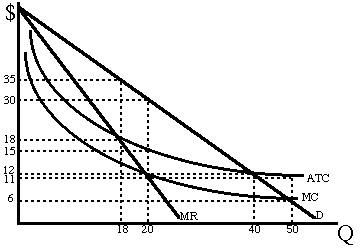
Figure 11
- a price of $12 and a quantity of 40.
- a price of $35 and a quantity of 18.
- a price of $18 and a quantity of 18.
- a price of $30 and a quantity of 20.
- a price of $6 and a quantity of 50.